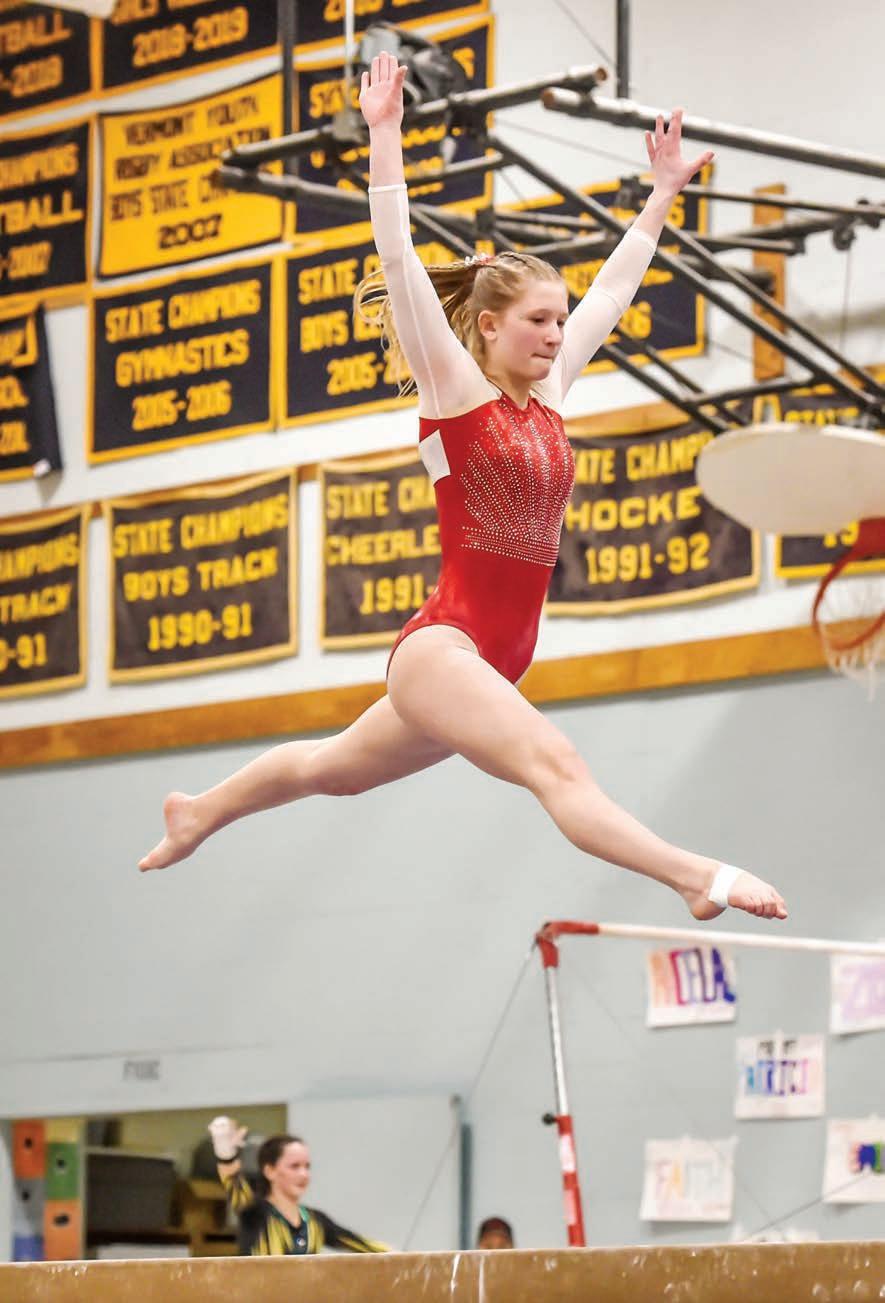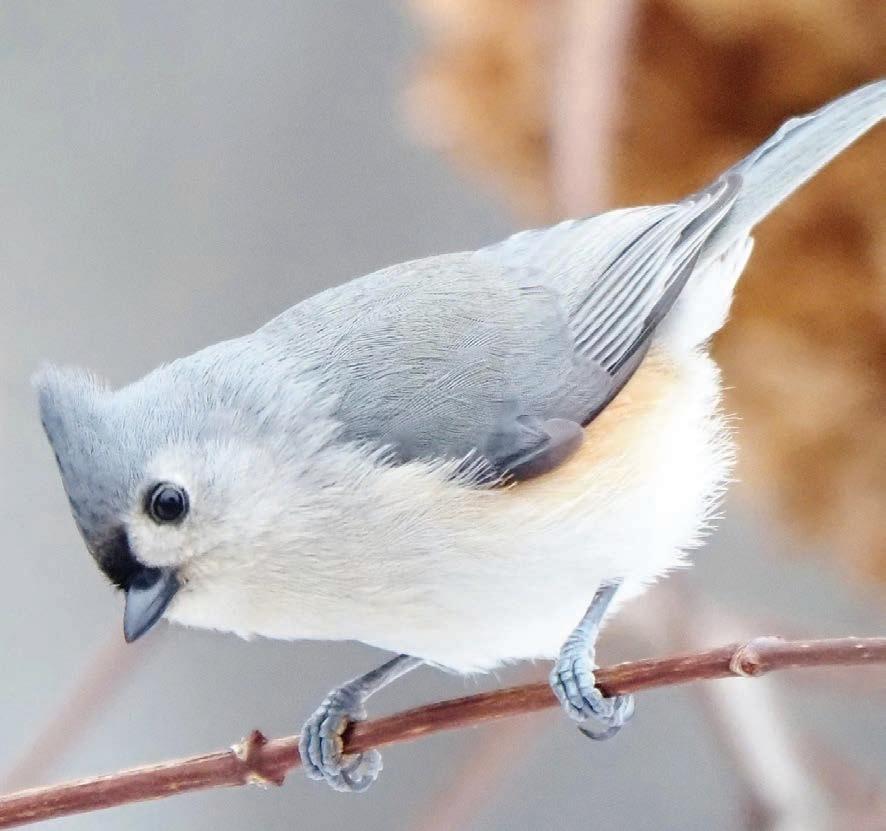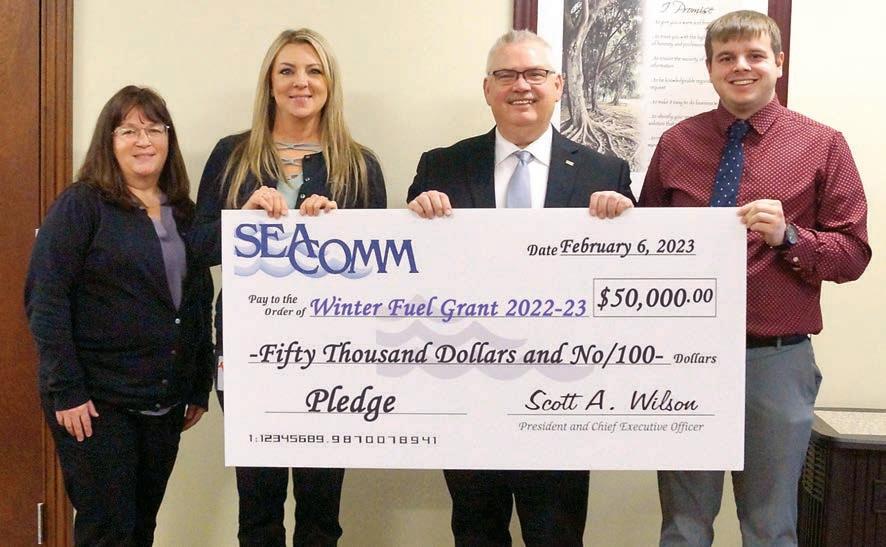Eager Equestrians
Local equestrian team places at regional finals

Page 16

Local equestrian team places at regional finals

Page 16
Joe Allen’s home in Hinesburg is near the Lake Iroquois dam, with a steep shoreline and a “tiny beach” on the property. When wake boats motor across the 247-acre lake, the resulting waves cause all sorts of disruption.
“I’ve seen small children get knocked down by these waves, (and) they make it a challenge to people walking on the neighbor’s floating docks,” he said.
Allen was one of more than 60 people — and at least a dozen Hinesburg residents — who voiced their support during a public meeting last week on a draft rule that would significantly regulate the use of wake boats on

Vermont’s lake and ponds. Wake boats are motorboats designed to specifically produce large waves for wake boarding and wake surfing — the fastest growing segment of the watercraft and recreational boating industries, according to the National Marine Manufacturers Association.
“I’m sure wakeboarding is a lot of fun, but it should be done on large bodies of water,” Allen said.
Other states — Alabama, Tennessee, South Carolina, and Oregon, for example — have rules in effect regulating use of wake boats. But a new draft rule that the Vermont Department of Environmental Conservation has prepared “would be by far the most restric-
See WAKE BOATS on page 11
The Charlotte selectboard convened as the town’s cannabis control commission for the first time on Feb. 13 after receiving their first cannabis license application since the selectboard voted itself to be the control commission in November.
On Feb. 1, the town received a referral from the state’s Cannabis Control Board regarding a mixed cultivator tier 1 license from Vermont Cultivars LLC which has already received state approval with a condition that the town’s
cannabis control commission indicate approval. Although municipality authority over applications is limited, members of the control commission expressed their frustration with how much information is kept from the commission once the application is received.
“I find it strange that it’s confidential, the person’s name and contact information,” said commission member Lewis Mudge. “It’s abnormal.”
“I want to join in on that, that is totally unacceptable,” said member Louise McCaren. “All it

Charlotte’s energy committee is working in partnership with two local solar companies for a campaign called “Solarize Charlotte” in the hopes of helping Charlotte reach renewable energy goals set within the town plan.
“It’s a win-win-win,” said chair of the energy committee Rebecca Foster. “Primarily for residents of Charlotte who participate in the program because they save money and also for the town because this helps us get closer to our goal of renewable energy production for the environment.”
The “Solarize Charlotte” initiative is an opportunity for solar providers and members of the town to work together to increase renewable energy production to help reach Charlotte’s goal of 90 percent renewable energy by 2050. This partnership provides town residents with discounts and support through the process while providing local solar providers with jobs in concentrated areas.
“It’s a program to encourage residents to get solar panels on their roofs and by working with particular vendors, we can aggregate and get discounts,” said Foster.
According to the energy committee’s findings, solar significantly lowers utility bills and with the world moving away from fossil fuels — which are rapidly getting more expensive — the committee doesn’t want Charlotters to be left behind. Thanks to the Inflation Reduction Act which was signed on Aug. 16, the federal government now offers a 30 percent tax credit on installed solar panels any time this year through the end of 2032. Although this is a reboot of older federal tax credits, this is an attempt to incentivize homeowner to make the investment of installing solar panels. According to whitehouse. gov, the Department of Energy estimates that the clean energy provisions of the Inflation Reduction Act and the Bipartisan Infrastructure Law together could reduce emissions by more than 1,000 million metric tons of CO2 emission by 2030.
The energy committee’s summer interns reached out to seven local solar providers before the committee ultimately landed on local companies Green Mountain Solar and DC Energy Innovations for the partnership. Both companies have agreed to a two percent discount for 10 homes,
four percent for 20 homes and six percent for 30 homes.
“If you’re a resident here in Charlotte, you can shop around between those two. You could also choose anybody else, but these are the two companies that are participating with us to give discounts,” explained Foster. “It may seem like a small discount, but it’s actually a big deal because the cost of installing solar has come down so drastically in the last 10 years. And all these companies are not overcharging in any way. The fact that they’re willing to give any discount at all, I appreciate that.”
Charlotte isn’t the first town to adopt a solar campaign; towns like Norwich, Windsor and Hartland have all successfully initiated the movement. President of Green Mountain Solar Paul Lesure said that when the company is presented with an opportunity to partner with a town “we jump on it.”
“It’s energy independence for a lot of individuals, but as well as towns when you’re able to produce more of your power locally, it gives you a bit of a resiliency, whether that’s at the individual homeowner level of having solar and batteries,
so that if a grid goes down, you’re good,” said Lesure. “Also, as we face climate change, having more locally produced energy really hardens our resources for future power production. Then obviously, the big one of climate change is we have a warming planet and the more we produce with solar, the fewer emissions we have to really fuel that system.”
Lesure also sits on the board for Renewable Energy Vermont, which has helped lead the state’s renewable energy revolution since 2001. This year, they are working to retool the current Renewable Energy Standard that says just 75 percent of the state’s electricity needs to come from renewables like wind, solar and hydro power by 2032. And just 10 percent of that power needs to come from in-state sources. In other words, the vast majority of the impacts of generating the electricity are inflicted on communities outside the state.
With the increased savings with the federal Inflation Reduction Act, Renewable Energy Vermont’s top priority for 2023 is to have the Vermont Legisla-
ture pass an updated version of the Renewable Energy Standard so that 100 percent of Vermont’s electricity truly comes from renewable resources while also doubling the amount of renewable energy generated in the state by no later than 2030.

Both Lesure and Foster believe that town- wide solarizing campaigns help the state reach these goals while also working to educate residents. “Macro scale, it’s really just about creating awareness. We’re in Vermont, it’s not like anyone doesn’t know solar exists,” explained Lesure. “But when you have a town or a third party talking about the value of solar and really rallying the community around it, it helps get people moving and get that ball rolling at a lot greater scale than we can do as a company. That partnership offers the value of really helping speed up the process of the solarization of Vermont.

The energy committee is currently looking to hire a community consultant to conduct on the ground outreach and education in time for an informational kickoff meeting on Earth Day, April 22.

Pathways Vermont’s Training Institute has received a $15,000 grant from the Four Pines Fund to expand our Conversations About Suicide training. This training is a participatory workshop intended to engage people in conversations about suicide in ways that prioritize compassion, empathy, and autonomy. It helps to address the stigmas around suicide and gives individuals a sense of agency and
support around feeling helpless and alone.

Participants in Conversations About Suicide work in social services including housing, community mental health, and crisis/support lines. The training is also open to anyone with a personal connection to suicide. The facilitator, J Helms, is a psychiatric survivor, advocate, educator, and writer. Helms is
Pathways Vermont’s Director of Training and Advocacy.
“Participants spend time unpacking suicide as a language of pain, then consider ways to support folks who are thinking about dying,” said Helms. “Through sharing personal stories, opening dialogue, and practicing difficult conversations, the group educates and supports each other to remain curious, lean into discomfort, and center mutuality.”
Pathways Vermont’s goal with this funding is to increase the frequency, reach, and resources to recruit, train, and hire folks with lived experience to expand the network of trainers who can offer Conversations About Suicide around the state.
Learn more about this and other upcoming trainings on our Pathways Vermont Training Institute webpage, https://bit.ly/3KdgYsB.
“It’s a win-winwin. Primarily for residents of Charlotte who participate in the program because they save money and also for the town because this helps us get closer to our goal of renewable energy production for the environment.”
— Rebecca Foster
If it’s important to you or your community look for it in The Citizen
“Journaling in Paint” is a collection of personal pieces by Shelburne artist Elisabeth Miller now showing in the community room of Pierson Library through April.
An opening reception will be held Saturday, Feb. 25, 305 p.m.

“Working as a portrait artist has reserved the genres of still life and interior for personal expression and exploration,” Miller
said. “These paintings are as pages torn from a journal. Created over a span of 10 years, they contain a few of the musings and observations of a life spent behind the easel.”
Growing up both rural Addison County and Spain to missionary parents, Miller has always been inspired by Europe’s masters.
“I like to capture beautiful things for their own sake, and the




urge to make lasting memorials to the people, places and truths that give life its meaning,” she said.
Miller began rigorously studying art at 12. She is a graduate of the Grand Central Academy of Art and earned her master’s degree of fine art from The New York Academy of Art.
She offers masters art instruction at her studio in Shelburne. When not painting, she enjoys strolling through the Shelburne Museum or exploring the rocky shores of Lake Champlain.


Total incidents: 37
Arrests: 0
Traffic stops: 7
Feb. 14 at 1:20 p.m., a citizen was assisted with fingerprinting for employment purposes.
Feb. 14 at 1:25 p.m., a citizen was assisted with fingerprinting for employment purposes.
Feb. 14 at 4 p.m., an officer investigated a theft from a motor vehicle on Jourdan Street.
Feb. 14 at 4:30 p.m., damage to a motor vehicle on CVU Road was reported and investigated.
Feb. 14 5:45 p.m., an officer assisted a citizen with a civil issue stemming from a dispute.
Feb. 14 at 7:45 p.m., a traffic stop was conducted on Richmond Road. The operator was charged with the offense of excessive speed.
Feb. 14 at 8:45 p.m., officers assisted first responders with a medical emergency on Richmond Road.
Feb. 15 at 5:50 a.m., an officer investigated a commercial burglary alarm activation on Beecher Hill Road.
Feb. 15 at 7:13 a.m., A 911 hang up on Mill Road was investigated.
Feb. 15 at 9:25 a.m., a violation of a relief from abuse order was reported and investigated.
Feb. 15 at 9:30 a.m., an officer investigated the report of suspicious activity on Lake Iroquois.
Feb. 15 at 9:45 a.m., a fraud case was reported and investigated.
Feb. 15 at 2:30 p.m., officers responded to Lantman’s Market for the report of suspicious activity.
Feb. 15 at 4:45 p.m., an officer investigated the report of a two-car motor vehicle crash on CVU Road.
Feb. 15 at 7:45 p.m., a traffic hazard involving livestock in the roadway on Hollow Road was investigated.
Feb. 15 at 8:55 p.m., an officer responded to Gilman Road to assist first responders with a medical alarm activation.
Feb. 15 at 9:40 p.m., officers responded to a domestic dispute on Hayden Hill West Road.
Feb. 16 at 3:05 p.m., a resident was assisted with fingerprinting for employment purposes.
Feb.16 at 3:45 p.m., an officer investigated the report of a two-car motor vehicle crash on Pond Road.
Feb. 16 at 5:40 p.m., officers assisted a person with a lockout on Route 116.
Feb. 16 at 7:35 p.m., an officer investigated the report of stolen property on CVU Road.
Feb. 17 at 8:35 a.m., a suspicious vehicle reported on Route 116 was investigated.
Feb. 17 at 3:20 p.m., a citizen was assisted with fingerprinting for employment purposes.
Advertising Wendy Ewing wendy@shelburnenews.com
(802) 985-3091 x12
Advertising Director
Judy Kearns judy@otherpapersbvt.com
(802) 864-6670 x21

Managing Editor
Dylan Kelley dylan@stowereporter.com
News Editor
Tommy Gardner
Staff Writers
Aaron Calvin
Corey McDonald
Liberty Darr
Production Manager
Stephanie Manning stephanie@shelburnenews.com
Editor/Publisher Gregory Popa gpopa@stowereporter.com
Billing inquiries Leslie Lafountain leslie@stowereporter.com (802) 253-2101
Advertising submission deadline: Friday at 5 p.m. advertising@thecitizenvt.com classifieds@thecitizenvt.com
Editorial submission deadline: Friday at 5 p.m. news@thecitizenvt.com
Calendar submission deadline: Friday at 12 p.m. news@thecitizenvt.com
Contact: 1340 Williston Road South Burlington, VT 05403 (802) 985-3091
Feb. 18 at 11:06 a.m., officers responded to a two-car motor vehicle crash on Route 116.
Feb. 18 at 1:55 p.m., suspicious
activity on Route 116 was investigated.
Feb. 18 at 6:10 p.m., a 911 hang up on Silver Street was inves-
tigated.
Feb. 18 at 11:55 p.m., a noise complaint on Route 116 was investigated.
 Kelly Stoddard Poor
Kelly Stoddard Poor
In the past year, local news outlets have covered recurring instances of essential housing projects being delayed by one or a few people. Stories from Jericho, South Burlington, Middlebury, Williston, Castleton, Waterbury, Morristown, Burlington, Winooski, Hartford, Putney and others highlight how easy it is to obstruct housing progress in Vermont.
Legislators of all parties, businesses from all industries and communities across the state, agree that housing is the foundational challenge for Vermont right now. We
To the Editor:
can no longer allow state and local regulatory processes to be weaponized to derail housing opportunities.
This must stop.
Over 85 municipalities have adopted a declaration of inclusion, an initiative with the intent to attract people with myriad skills and traditions to Vermont to live, work and raise families in a state that values and encourages diversity in its population. But when it comes to building housing for new community members, Vermonters in these same cities and towns are discouraging development.


For an economically secure, sustainable and equitable future, Vermont needs more people of diverse backgrounds to move here to live and work. However, recent graduates and seasoned professionals alike
As an informed voter, it is important to understand the significance of the proposed budget for the Champlain Valley School District. This year, the district has proposed a budget of $96 million, which represents an increase of 7.5 percent from the current year.
Despite these increased costs, the proposed budget is still 1.2 percent below the statewide average for equalized pupils and 1 percent below the state average spending increase. This demonstrates the district’s commitment to being financially responsible while still providing the best possible education for its students.

The budget proposal takes into account various external forces, such as statewide and national health care increases, inflation and a tight labor market. Despite these challenges, the district remains dedicated to supporting all students and providing a high-quality education.
By voting for the proposed budget, you are supporting the education of the students in the Champlain Valley School District. Investing in our future through education is a vital part of ensuring a strong and thriving community.
Reach out to the school board with any questions at cvsdschoolboard@cvsdvt.org.
are deterred from coming to Vermont due to the shortage of suitable housing.

Additionally, we must better meet the needs of older Vermonters, who are essential members of our workforce and communities. There is a significant misalignment between the housing that is available and the type of housing Vermonters need and want. For older adults who want to downsize to modestly sized alternatives, the housing supply isn’t meeting their needs. Instead, downsizing often requires leaving their community altogether and parting with the place they’ve called home for years.
Seven years ago, the Vermont Futures Project set a target of bringing 5,000 new or retrofitted units online per year to keep supply in line with demand. Since then, we have seen hundreds of millions of dollars invested in housing, but the crisis continues to worsen.
Since 2016, the annual average of new units permitted has been under 2,000. This means we are moving backward rather than forward. While statewide investments are still part of the equation, a singular focus on investing tax dollars into housing must be broadened to create longterm and sustainable solutions for housing people of all ages and economic backgrounds.
The Vermont housing crisis requires bold leadership at both the state and local levels to reduce barriers to the creation of housing. Communities must take a stand against instances of individuals derailing projects that are in the public interest. Where state tax dollars have funded roadways, water systems and public buildings and resources, the state has an obligation to maximize these investments, and allow more people to live near these resources paid for with taxpayer dollars.
If housing is the top priority in the Legislature, we need to see the issue receive immediate and aggressive attention this legislative session. Legislation that makes real change to address our housing crisis should be the first bill on the governor’s desk this session.
To address the housing shortage, we recommend the following solutions:
• Modernize Act 250 and remove its requirements for housing in areas with state designations and restrict local zoning practices that inhibit the creation of housing options in smart growth areas. Exclusionary zoning and outdated land use regulations are adding prohibitive and often duplicative costs and delays.
See HOUSING on page 7
We

The CDC’s study shows that teen girls in America are “engulfed in a growing wave of violence and trauma,” according to its chief medical officer, with dramatic increases in online harassment and bullying, sexual assaults, and rapes. Various forms of harm inflicted on and attempts to harm themselves have also increased among teens of color and those questioning their sexual orientation.
The exposure of Fox News media personalities’, owners’, and management’s belief that Donald Trump’s big lie was just that, while continuing to give crackpots and liars a platform and pushing the lie that the 2020 election had been stolen.
The one-year mark of Russia’s criminal invasion of Ukraine, carrying out a genocide and crimes against humanity.
At first glance, these might seem unrelated, but to miss the common thread is to miss the continuing fascistic authoritarian movement, not only in our country, but worldwide. You would also miss the role that the media on the right, not only Fox News,
plays in advancing this movement and the impact it has had in reshaping our culture in the past seven years. No, defeating Trump in 2020 was not the end.
We’ll get to Ukraine shortly, but first, let’s look at common themes being pushed on the political right in the U.S., not just the far right, but by the pool of most likely Republican nominees for president in 2024:
• Men are being emasculated and need to reclaim their dominant role in society
• Whites are being replaced in society, economically, and politically by people of color, especially immigrants, with the goal of repressing the rights of Whites.
• White Christian Nationalist “values” need to be imposed on all areas of our lives including sexual orientation, gender identity, reproductive rights, women’s roles in society — both inside and outside the home, and, of course, white dominance
• Reacting with violence and aggression is an unavoidable and reasonable response to feeling politically, socially, or economically at risk
Most of the analysis, thus far, of the latest “Youth Risk Behavior Survey” conducted annually
Promote your program in our Summer Camps guide for targeted exposure to a local audience of kids and parents as they make plans for the upcoming summer season. This advertising section is a go-to guide for summer camp and recreation researchers, making it the ideal place to outline your offerings and secure more early enrollments.
Publication Dates: March 9 and April 6
Deadlines: Thursdays before each issue
Contact: Stowe Reporter/News & Citizen at 802-253-2101, Shelburne News/The Citizen at 802-985-3091 or The Other Paper at 802-864-6670 for information or to advertise your camp (ask about multi-paper, half-price color and Burlington Area Newspaper Group deals).


by the CDC assumes that the COVID-19 pandemic and related school closures and lockdowns are largely responsible for startling deterioration of teen girls’ mental health. I have no doubt that the pandemic is a contributing factor, but the beginning of the slide predates the pandemic. COVID also fails to explain why girls, non-white teens, and those questioning their sexual orientation are faring much more poorly than boys. The report includes this jaw-dropping passage: In 2021, nearly 30 percent of female students drank alcohol during the past 30 days. Almost 20 percent of female students experienced sexual violence by anyone during the past year and 14 percent had ever been physically forced to have sex. Although these numbers are high, the rates of poor mental health and suicidal thoughts and behaviors are even higher. In 2021, almost 60 percent of female students experienced persistent feelings of sadness or hopelessness during the past year and nearly 25
percent made a suicide plan. That is a 60 percent increase in teen girls considering suicide over the past decade and a 27 percent increase in girls reporting forced sex in just two years. This isn’t an acceleration in the percentage of girls reporting forced sex — it’s the first time since the CDC start collection data that there has been an increase at all.
The data on LGBQ+ students is no less troubling. Data on transgender teens, unfortunately, was not collected though it will be in future surveys. There is certainly no reason to believe trans teens are faring better. More from the CDC report:
They were also significantly more likely to experience all forms of violence. The differences in terms of mental health, compared to their peers, are substantial. Close to 70 percent of LGBQ+ students experienced persistent feelings of sadness or hopelessness during the past year, and more than 50 percent had poor mental health
during the past 30 days. Almost 25 percent attempted suicide during the past year.
Our county’s history of failing and continued neglect of communities of showed up in school and community safety data: “Experiences of violence by racial and ethnic groups show that Black and Hispanic students were more likely to not go to school because of safety concerns, suggesting exposure to environmental violence in communities and schools.”
Are we really going to pretend that our kids swimming in a toxic concoction of white grievance, glorification of hypermasculinity, and an aggressive anti-LGBTQ social and legislative movement championed by Christian Nationalists is not a major contributing factor?
The report does not merely report all this tragic data, but makes recommendations, also based on data, on what can help. The CDC sees profound potential for schools to be key component of improving the lives of teens. Among its recommendations are increasing access to mental health services through schools, gay-straight alliance clubs to
To learn more or reserve your space, talk to us today!
“To miss the common thread is to miss the continuing fascistic authoritarian movement.”

The recent incident in Corinth with a dog being caught in an illegal trap set has spurred fresh commentary calling for more restrictions or a complete ban on trapping in Vermont.
The oft-repeated falsehoods prove a tired technique that believes if you tell lies often
TRAUMA
continued from page 6
build understanding and relationships, more and better health education, which includes sexual and emotional health.
All these recommendations to reduce sexual and other forms of violence, suicidal feelings and attempts, and rates of drug and alcohol use are opposed by the 2024 GOP presidential frontrunners. Donald Trump, the most likely nominee, is a self-admitted sexual assailant. Ron DeSantis has not only championed “Don’t Say Gay” legislation, now laws, in Florida, but he’s taking his LGBTQ-Hate-Show on the road, encouraging other states to use his state’s new laws as a model. Why? Because he knows that LGBTQ hate sells with the GOP base voters. Layer bans on teaching accurate American history on race, overturning Roe and imposing bans on abortion even in cases of rape and incest and the message to girls, LGBTQ+ teens, and kids of color is clear. Is it any wonder that these groups of teens being bombarded by messages that they are worthless are making them feel worthless?
As promised, here is how Russia’s war crimes and genocide in Ukraine, the American right’s media machine, and these terrible data on America’s teens all fit into this horrific big picture.
Here is just a partial list of the “Early warning signs of fascism” in the U.S. Holocaust Museum:
• Powerful and continuing nationalism
• Disdain for human rights
• Identification of enemies as a unifying cause

• Supremacy of the military
• Rampant sexism
• Controlled mass media
• Obsession with national security
• Religion and government intertwined
• Corporate power protected
• Labor power suppressed
• Disdain for intellectuals & the arts
• Obsession with crime &
enough to those uninformed, you will gain support in your unsupported arguments.
No one more than a trapper wants to avoid catching a domestic dog. We own and love our pets as much as anyone else. And the statistical occurrence of catching pets is extremely rare.
I started trapping over 55 years ago and have caught exactly one dog. The beagle was released without a scratch and started
punishment
• Rampant cronyism & corruption
• Fraudulent elections
Fascistic authoritarianism in our country is not inevitable, but we have learned in the past seven years that the same is true of democracy. If we want the latter to prevail, we must acknowledge the advances of the former. The harm to our children is already occurring and accelerating. It’s up to all of us to determine if this foreshadows their future or is an ugly chapter in history that generations to come are allowed to study.
Lisa Senecal is a writer, host of The Lincoln Project’s “We’re Speaking” streaming show, co-chair of the Vermont Commission on Women, board member of the Clarina Howard Nichols Center and a member of Allies for Accountability, a citizens’ action group founded to hold public officials accountable and support survivors of sexual assault. She lives in Craftsbury.
following me out of the woods. I took it home, kept her overnight, found the owner and returned it the next day. I would have inherited that dog if the owner could not be found. By the way, bear hunters love their dogs too.
Hunters live and breathe their dogs year-round. Though it cannot be measured, believe me when I say that the dogs and cats saved from being killed by fisher, bobcats, foxes and coyotes by regulated trapping is several magnitudes greater than those caught or killed in traps. So, the charges of trapping being indiscriminate, cruel and unregulated are generated by emotion and disproportionally highlighting extreme and rare occurrences. Some of my colleagues have competently addressed these issues. But I do want to talk about the greater umbrella surrounding trapping and wildlife management in general.
Furbearer species, along with most wildlife, are generally very short-lived compared to humans.
continued from page 5
This hinders the ability of Vermont to welcome a new and diverse population to live and work here. It restricts the ability to build age-friendly homes for older Vermonters and to create more housing opportunities for Vermonters of color who want to remain here.
• Increase the workforce housing supply with a dedicated strategy for middle-income earners to access a progression of housing from tenancy to homeownership. Provide financial
Five years can be old, with reaching 10 years old often ancient. Along with this phenomenon often comes a high birth rate with a surplus of young every year.
This surplus results in high yearly mortality by many natural causes, all far less humane than being taken by trapping. The ongoing fragmentation of suitable habitat with increased development further compounds this situation.
Regulated trapping and harvest will increasingly be more of the solution rather than the problem in the future by keeping furbearers in harmonic alignment with biological and societal carrying capacities.
Finally, I want to address the idea that the Vermont Fish & Wildlife Department ignores trapping and other activities. I can say from decades of involvement with the department that it is very clear-eyed about trapping and other extensions of sound conservation principles of game and nongame species alike.
This is what they are trained
to do, and they do it very well.
Trappers are an ally and play an integral role in furbearer management by providing biological data that could not be obtained otherwise. Mandatory trapper reports are collected each year that show all species harvest numbers and trapper effort. The location and watershed of taken otter, fisher and bobcats are noted, along with the carcasses of these species being surrendered for biological necropsy.
Regulations and management can be altered by this information.

The ecological understanding and reverence that we feel is enhanced by direct experience with the natural world and lessened by the lack thereof. Trapping, hunting and other consumptive activities provide a historical conduit to that world. That ancient, indigenous wisdom should remain intact.
Paul F. Noel of Irasburg is a lifelong sportsman and conservationist
incentives to assist communities with the necessary infrastructure and planning resources to create housing opportunities for rural, aging and historically marginalized Vermonters.

• Bring employers, developers and government/non-government stakeholders together to find and finance housing opportunities in employment hubs. We need more voices with new ideas at the table to find new solutions.
• Create a statewide registry of short-term rentals to under-
stand how these operations are impacting the housing market for both rental and homeownership opportunities.
Megan Sullivan is vice president of government affairs for the Vermont Chamber of Commerce. Tino Rutanhira is co-founder and board chair for the Vermont Professionals of Color Network, and Kelly Stoddard Poor is director of advocacy and outreach for AARP Vermont.
The Charlotte Volunteer Fire and Rescue Service is offering the very popular “express” CPR class. In less than two hours you can learn how to give CPR compressions, how to use an AED and how to assist adult and infant choking victims.
This course does not lead to certification but does teach many of the same skills taught in the certification classes. This class is Saturday, Feb. 25. starting at 9:30 a.m. at the Charlotte Fire Station. There is a $10 fee.
To register for this class please go to bit.ly/3xk9sEs and sign up. Space is limited. For questions, email cprR@cvfrs.org.
Join the Hinesburg Firefighters Association for their spring craft fair, Saturday May 20, from 9 a.m. to 3 p.m. at the Hinesburg

fire station.
The event will include local crafters as well as outside business consultants and many home craft businesses. If you are interested in a space, contact dbarber7541@ gmail.com. Proceeds from event benefit the Hinesburg Firefighters Association.
Bring questions and concerns for a legislative meet-and-greet with Rep. Chea Waters Evans, the Charlotte and Hinesburg representative in the Chittenden-5 House District on Monday, Feb. 27, at 1 p.m., at the Charlotte Senior Center.
Cochran’s Ski Area hosts Nordic Cross Race
On Sunday, April 2, Cochran’s Ski Area will hold its annual Nordic Ski Cross Race. This fun
See COMMUNITY NOTES on page 9
With interesting, fun and smart information and stunning photography and design, couples look to our magazine to plan their wedding in northern and central Vermont.


Anticipated winter chill and the rising cost of heating expenses compelled SeaComm Federal Credit Union help its members in need. Last November SeaComm pledged $50,000 to help with home heating costs. The credit union’s members were invited to apply for the grant electronically through its website, by visiting one of its nine branch locations or via mail service. With nearly 1,000 applications received across northern New York and Vermont, the credit union’s fuel grant committee selected 100 members to receive fuel grants worth $500 each. The credit union has locations in South Burlington and Essex. From left, SeaComm dealer relationship manager Danielle Uppstrom, mortgage manager Tara Cusworth, president and CEO Scott A. Wilson and loan operations representative Chandler LaPlante.
• A destination-wedding guide to the best wedding vendors
• Focused on the iconic central and northern Vermont regions
• Distribution at select retailers and industry experts, newsstands and online • Each display ad includes a wedding directory listing
continued from page 8
and challenging competition is for all ages and includes uphill, downhill, slalom gates, jumps and obstacles — all on one pair of skis.
Bring the whole family to watch. The race also includes a free pancake feast with hot slopeside syrup for all competitors and a shorter course for kids. Prizes awarded for top three in all age categories.
The fastest eight men and fastest eight women compete head-to-head in an all-out chaotic gun for the finish. Tickets are $25 per person at cochranskiarea.com. Start time is 11 a.m. for kids and 12:30 p.m. for adults.
For more information contact mrand@ gmavt.net or call 802-373-7204.
The League of Women Voters of Vermont Education Fund is now accepting applications for its Winona Smith Scholarship program.
Created in 1998 to honor the legacy of League leader Winona Smith, the scholarship is awarded annually to local high school seniors who embody the characteristics and qualities Smith displayed of civic participation and community service.
Four $1,500 scholarships will be awarded to students based on financial need, scholastic achievement and teacher recommendations.
Applications, due on May 1, are available at bit.ly/lwvscholarshipdetails. Students need to submit two essays, one on issues concerning voting rights and the other on the impact of a recent civic, national or world event. A letter of recommendation from a teacher is also required.
Direct questions to lwvofvt.edfund@ gmail.com.
The Age Well meal for Thursday, Feb. 23, is 10 – 11 a.m., at the Charlotte Senior Center and features oven fried chicken, red mashed potatoes with sour cream, Capri blend vegetables with lentils, wheat bread and butter, pumpkin custard with cream and milk.
You must have pre-registered by the prior Monday by contacting 802-425-6345 or kpughe@charlotteseniorcentervt.org
The meal on Thursday, March 2, features diced beef with potatoes and burgundy wine sauce, broccoli florets, Craisin muffin with butter, strawberry shortcake with cream and milk.
The suggested donation is $5. Check the website for last-minute cancellations at https://bit.ly/3IruDLi.
The Vermont Historical Society’s winter speaker series brings together several experts to explore various facets of the state’s history.

The online series is free to the public. Here’s the schedule for this year’s series:
• March 15: Bringing Geography Home: Genieve Lamson and the Vermont Commission on Country Life with Tom Anderson-Monterosso. On Jan. 16, 1923, geographer Lamson (1887–1966) of Randolph became the first woman to address an annual meeting of the Vermont Historical Society in its 85-year history.
Six years later, she took a leave from teaching at Vassar College to study population shifts, especially those of immigrant farm families, for the Vermont Commission
of Country Life, best known today for its advocacy of eugenics.
Bucking the biases of her employers, Lamson’s results celebrated pluralism, told marginalized women’s stories — and were sidelined. Marking the 100th anniversary of Lamson’s address and Women’s History Month, this talk will bring to light Lamson’s long-overlooked work for the commission and place it in the context of her education, politics, and career as an academic with an abiding passion for her home state and all its people.
• April 19: A New American Globe: James Wilson of Vermont with Amanda Kay Gustin.
In 1810, James Wilson, a farmer from Bradford, made something extraordinary: the


first American-made globes for sale in history. With little formal schooling and no real scientific background, he had made an object of astonishing detail and incredible beauty. His globes made their way into classrooms and homes across America for the next 50 years, a less expensive alternative to imported English globes and an education phenomenon.
Gustin is the director of collections and access at the Vermont Historical Society, where she works on statewide projects that examine and share Vermont’s history, including public programs, research projects, and exhibits, and supervises the work of the research library and museum collections.
Register for the event at form.jotform. com/223153874879167.
‘Here’s the spot!’
Buying and shopping locally helps independent businesses, which in turn helps all of us shape our community’s distinct flavor, personality and character.
not look back in a win over Burlington on Monday.
Burlington-Colchester 1, Champlain Valley-Mount Mansfield 0: Burlington-Colchester tallied the only goal of the game in the second period to squeak out a win over Champlain ValleyMount Mansfield in girls hockey on Saturday. Grace Ferguson stopped 24 shots on goal for the CougarHawks, who fell to 13-5-1.
Colchester 5, Champlain Valley 3: Champlain Valley could not keep up offensively as they fell to Colchester on Saturday. Travis Stroh and Jack Bryan scored for the Redhawks, who fell to 7-9-3 with the loss. Jason Douglas made 37 saves in goal.

Champlain Valley 61, Burlington 40: The Champlain Valley boys basketball team jumped out to a 30-11 lead at halftime and did
Tucker Tharpe nearly had a double-double, scoring 18 points and nabbing nine rebounds, to pace the Redhawks, who move to 17-1 with the win.
Kyle Eaton added 17 points and eight rebounds for CVU. The Redhawks also got a win on Thursday, beating Colchester 47-34. Sam Sweeney led all scorers with 13 points, while Tharpe (12 points) and Logan Vaughn (10 points) also hit double digits.
The Champlain Valley gymnastics team competed in the Vermont high school state championships on Saturday, coming in third place overall.
Ruby Opton was the top finisher for the Redhawks, earning a third place finish on the beam.
Warner Barbic came in sixth in the bars to give CVU another top finisher and Jasmine Dye was eighth on the floor exercise.
Burr and Burton claimed the top spot and the state title, while Essex came in second place.
The Champlain Valley girls basketball team wrapped up the regular season with an undefeated Vermont schedule and the top seed in the Division I playoffs.

The Redhawks will head straight to a quarterfinal matchup after earning the No. 1 seed, awaiting the winner of No. 9 Colchester vs. No. 8 Rice. The winner will face CVU on Friday at 7 p.m.
CVU wrapped up the regular season with a 48-32 win over Rice on Saturday, securing the top seed for the 10th time since 2012.
Shelby Companion led all scorers with 15 points for CVU, while Addi Hunter nine points and eight rebounds. Samara Ashooh chipped in with seven points and seven rebounds.
The Redhawks took on Rice twice in the regular season, winning both matchups, and did not face Colchester.
CANNABIS
continued from page 1
does is create angst.”
When a completed application for any type of cannabis establishment license is received, the Cannabis Control Board will send a report to the local control commission of the town where the establishment plans to operate. The report includes the name and principles of the cannabis establishment along with a series of “yes” or “no” questions but other information like name of the applicant, contact information and location is redacted.
Nellie Marvel, the outreach and education manager for the Cannabis Control Board, explained that a town’s decision to have a local control commission does not in any way expand the town’s authority to regulate cannabis establishments. It only creates a specific regulatory body that looks over applications and evaluates them for the same three criteria that fall to any municipality to regulate: zoning, public nuisance and signage.
“Those are the three areas that any municipality including those that have local control commissions have the authority to regulate,” she said. “When a town opts to create a local control commission that essentially means that
continued from page 1
tive rule in the U.S.,” said Oliver Pearson, the lakes and ponds program manager with the DEC.
Efforts to regulate wake boats have gained traction since March of last year, when Responsible Wakes for Vermont Lakes petitioned the state Agency of Natural Resources, urging the state to restrict them to at least 1,000 feet away from shorelines and in water that is at least 20 feet deep.
The group identified Lake Iroquois in Hinesburg as one of more than a dozen lakes throughout the state where wake boats and wake-enhancing devices can cause environmental damage. The Hinesburg selectboard in June then sent a letter of support to the state asking them to study the issue and develop regulations.
The draft rule would allow wake boats on 31 Vermont lakes, under the conditions that the boats stay 500 feet from the shore on all sides and in water at least 20 feet deep. Boats must also stay in one lake per calendar year to mitigate the spread of invasive species like zebra mussels.
“We anticipate that there’ll be lots of people who criticize this rule. Some will say it’s too restrictive. Others will say it’s not restrictive enough,” he said. “Sometimes I feel like if everybody hates you for different reasons, then you’re probably in the right place when it
creates one more permit that an applicant needs to have in place before they can begin operations. So, they have their license through the Cannabis Control Board and then they also have their local permit through the local control commission.”
“It’s the first application and you want to come into the town and grow pot, that’s fine but we should at least know the name and the contact details,” said Mudge.
Marvel explained that the reason that the state’s control board gives such limited information is for the grower’s confidentiality and privacy purposes.
“For instance, a lot of our cultivators have expressed concerns to us, rightly so. There have been instances in other states where their addresses get published, and then come September when their crop is flowering and about ready for harvest people have seen their crops stolen before they’ve had a chance to actually harvest and reap the benefits of their labor,” she said.
At the meeting, Mudge was vocal about the “quote-unquote … security reasons” and expressed concern for ensuring that nearby potential neighbors are made aware
of an incoming cannabis cultivation site. Town administrator Dean Bloch said neighbors would be notified during the permitting process which, because Charlotte does not yet officially have land use regulations that reflect the cannabis market, requires applicants to first go before the development review board to gain conditional use approval. However, the planning commission is currently in the works of crafting brand new cannabis regulations that they are hoping to present to the selectboard in the coming months.
“What we’re trying to do is create these fairly clear standards about what kinds of cannabis businesses can operate in what parts of town and what are the specific standards that we would apply,” said the town planner Larry Lewack. “So, when we do get an application before the town’s development review board, we have something
to look at and to base our decision on because, right now, we’re essentially making it up.”
The decision regarding the Vermont Cultivars LLC application was postponed because members claimed the “report” sent to Bloch from the state was not included in the selectboard meeting packet that is given prior to each meeting. Bloch told the commission he could print out the one-page notification for review prior to the meeting ending but after much discussion, members opted to nix the item until the next selectboard meeting on March 13.
“It seems like everyone has an opinion, so why don’t we just postpone this and put it on a different agenda,” said selectboard chair and commission member Jim Faulkner. “Maybe the best thing for us to do is get that information, process it and then have another meeting on it.”
“I’m just trying to look at the rules here that were given to us,” responded member Frank Tenney.
“I think Frank is correct,” said Mudge “Even if it is a one liner, sorry. We should get a report or bar notification.”
comes to regulation.”
But for most of the meeting last week, speakers called for even more restrictive regulations on the boats — as laid out in Responsible Wakes for Vermont Lakes’ original petition.
“Your responsibility is to adopt rules which protect the public waters of our wonderful state, it’s not to try to reach a compromise with wake boat owners,” said Peter Erb of Hinesburg. “There’s strong evidence that 1,000-foot setback should be mandated, and to adopt less will not be in the interest of the protection of these waters, but some baseless accommodation to a relative tiny group of people in the waters that are your responsibility to protect.”
Opponents say the draft rule would be overly restrictive — that there’s little evidence showing a need for 1,000-foot offset, and, according to studies conducted by the industry, 200 feet is just fine. But advocates for more stringent regulations on wake boats have pointed to studies showing the environmental harm their wakes produce.
Wake boats have a stronger wake than more conventional motorboats, and the downward direction propeller wires can distort lake bottom sediments.
“We’re concerned about this, particularly in Vermont, where

there’s a lot of sediment from many years of surface water runoff into our lakes through our tributaries,” which often contain nitrogen and phosphorous, Pearson said.
If that sediment is disturbed, that phosphorus could come up into the water column, become available for plant and algae growth, and can contribute to growth of invasive species and cyanobacteria blooms, said Laura Dlugolecki, with the state DEC.
“This is a big concern for water quality in Vermont,” she said. Studies have also shown that because of their ballast tanks, wake boats spread invasive species when moved between water bodies.
The DEC has held three public hearings thus far — one in Richmond, Manchester and, on Feb. 15, in Greensboro. They released their draft rule on Jan. 31, but that will still have to go through a robust process before it becomes law.
DEC officials said during the meeting that they would take into consideration comments aired during the meeting on Wednesday.
“Eventually, we hope to submit... to the legal formal rule making process, and there will be another public hearing, or public hearings, given the amount of interested in this issue,” Pearson said. “There are still other bites at the apple to influence this process.”
local permitting. Oborne did not respond for comment after multiple attempts, but Lewack explained that “(Oborne) has determined that because a medical cannabis grow was previously permitted at that same site by a prior zoning administrator in Charlotte, he is treating that as a permitted use and will be permitting this new operator shortly. Following issuance of that permit, he will notify the selectboard of that fact. They will do their own review and then decide about granting a local license, acting as the local cannabis control commission.”
Because of this “grandfathered” use on that site, it’s a simpler process than conditional use review before the development review board. All three of the other cannabis cultivations that are up for state license renewals this year will have to undergo conditional use review before they can proceed for their local license review. The first of the three, Boreas Ventures LLC, has a sketch plan review before the development review board on Feb. 22 after the Citizen goes to press and neighbors have already elicited their support for the project.
Bloch explained that at the time of the meeting, Vermont Cultivars LLC had been in contact with the town’s zoning administrator Keith Oborne to get up to speed on
An email signed by ten neighboring residents sent to the development review board prior to the hearing states: “We believe that the town of Charlotte should be welcoming this new generation of agricultural entrepreneurs, and not creating ill-conceived restrictions and policies that will make it difficult for these businesses to exist and thrive.”
“It seems like everyone has an opinion, so why don’t we just postpone this and put it on a different agenda.”
— Jim Faulkner
The Outside Story
Jen WeimerA winter walk in the forest reveals a flurry of wildlife activity that often goes unnoticed during other times of the year. Often among the many tracks in the snow are the nearly heart-shaped prints of deer. The white-tailed deer (Odocoileus virginianus) is common throughout the United States, with an estimated population of 30 million nationwide. In the Northeast, numbers range from roughly 100,000 deer in New Hampshire to 133,000 in Vermont and more than 300,000 in Maine. Deer are an important part of the ecosystem, but their foraging behavior can wreak havoc in forests, where browsing may contribute to the spread of invasive plants and decrease species diversity.
Deer are herbivores and feed on acorns, beechnuts and green vegetation including woody plants. One animal can consume up to nine pounds of food per day, and deer will forage urban backyards when food is scarce, making them a pest in some areas. Deer can live almost anywhere but do best in areas with a combination of fields and forest. In the north — where winters are harshest – they populate forested valleys with areas of dense conifers that provide cover.
Some of these conifers such as hemlock, fir and pine are at risk from invasive forest pests, including hemlock woolly adelgid, balsam woolly adelgid and red pine scale. Deer can spread these pests from one place to another as they move through infested areas and pick up eggs and crawlers on
their fur.
Deer can also spread invasive plants, directly and indirectly, through their feeding habits. When deer consume the fruit of invasive plants such as multiflora rose, oriental bittersweet and Japanese honeysuckle, the animals pass the seeds of these fruits in their drop-
TOWN OF CHARLOTTE IS ISSUING REQUESTS FOR MOWING/LAND MAINTENANCE & BRUSH-HOGGING BIDS
The Town of Charlotte is seeking bids for:
• mowing and maintaining certain town parcels and trails
• mowing and maintaining cemeteries
• brush-hogging certain town parcels
A description of the parcels and bid requirements can be viewed at www.charlottevt.org and can also be obtained at the Town Office. Contractors can bid on one, two or all three contracts.
Bids are due on Monday March 13, 2023 @ 4 PM.
Any questions should be directed to Dean Bloch, Town Administrator, at 425-3071 ext. 5 or townadmin@townofcharlotte.com
pings, allowing the plants to spread to new areas. Even seeds of invasive plants that deer don’t eat, such as Japanese stiltgrass, can spread if they are picked up on the animals’ hooves and dropped in other areas as deer move through the forest.
Deer avoid eating other invasive species — including glossy buckthorn, garlic mustard and Japanese barberry — which are either unappetizing or contain thorns which deter foraging. Over-browsing of native plants in areas with large deer populations enables these invasive species to flourish and displace native species. This change in forest composition negatively impacts the native wildlife species that depend on diverse forests with native plants. Invasive plants can also create undesirable monocultures when left to spread. Japanese barberry, for example, can become so dense that the plants create a humid environment that favors deer tick populations, thereby increasing the prevalence of Lyme disease.
What can be done to preserve our diverse forests? In the Northeast, deer populations are managed primarily through hunting. The
New Hampshire Fish and Game Department, for example, works with the public to develop a 10-year management plan aimed at achieving a desired population level of deer throughout the state. The department monitors deer populations within 20 wildlife management units annually throughout the state. Objectives outlined in the plan vary for each unit, depending on a two-year average of adult buck kill during the hunting season. Deer harvest is increased by issuing more permits in areas where deer populations exceed the carrying capacity of suitable habitat, impact animal and plant biodiversity or create too many conflicts with humans. Other states in the Northeast follow similar management practices.
Forest managers should also consider deer populations when managing invasive plants. Studies show that overstory tree species such as maple, oak and ash benefit when fencing is used to exclude deer from areas of forest regeneration. This is an expensive management option requiring ongoing maintenance, however, and is not always feasible.
ILLUSTRATION BY ADELAIDE MURPHY TYROLPrevention of invasive plants is especially critical in areas with high deer populations. Foresters may employ various management practices to limit the spread of invasives. These include scouting for invasives in advance of a timber harvest, laying out skid trails to avoid areas with invasives, and removing or treating invasives where possible. Operating tactics such as harvesting in un-infested areas first and moving from lesser to greater infested areas will also help to limit spread. Lastly, cleaning equipment after a harvest will ensure seeds are not spread to a new site.
With proper planning and management, foresters can help turn deer encounters from “Oh, dear!” to “Oh look, a deer!”
Jen Weimer is a forest health expert, photographer and writer living in the forests of New Hampshire. Illustration by Adelaide Murphy Tyrol. The Outside Story is assigned and edited by Northern Woodlands magazine and sponsored by the Wellborn Ecology Fund of the New Hampshire Charitable Foundation, nhcf.org.

for 2nd shift, 3pm-11pm, available immediately
Apply in person: 1016 Shelburne Road • South Burlington, VT 05403 or email travelodgeburlingtonvt@gmail.com
Why not have a job you love?
Positions include a sign on bonus, strong benefits package and the opportunity to work at one of the “Best Places to Work in Vermont”.

Service Coordinator: Continue your career in human services in a supportive environment by providing case management for individuals either for our Adult Family Care program or our Developmental Services program. The ideal candidate will have strong clinical, organizational & leadership skills and enjoy working in a team-oriented position. $47,000 annual salary, $1,500 sign on bonus.
Residential Program Manager: Coordinate staffed residential and community supports for an individual in their home. The ideal candidate will enjoy working in a team-oriented position, have strong clinical skills, and demonstrated leadership. $45,900 annual salary, $1,500 sign on bonus.
Direct Support Professional: Provide 1:1 supports to help individuals reach their goals in a variety of settings. This is a great position to start or continue your career in human services. Full and part time positions available starting at $19/hr, $1,000 sign on bonus.
Residential Direct Support Professional: Provide supports to an individual in their home and in the community in 24h shifts including asleep overnights in a private, furnished bedroom. You can work two days, receive full benefits and have five days off each week! Other flexible schedules available, starting wage is $20/hr, $1,000 sign on bonus.
Shared Living Provider: Move into someone’s home or have someone live with you to provide residential supports. There are a variety of opportunities available that could be the perfect match for you and your household. Salary varies dependent on individual care requirements. $1,000 sign on bonus.
Join our dedicated team and together we’ll build a community where everyone participates and belongs https://ccs-vt.org/current-openings/

Make a career making a difference and join our team today!
https://ccs-vt.org/current-openings/

• Daily substitute teachers and support staff at all subject levels
• Long-term substitute teachers in 2nd and 5th grade classrooms at Orchard

• Long-term substitute in a Science classroom at SBHS
Qualified candidates will have strong organizational and interpersonal skills, demonstrate an ability to effectively relate to students and manage a classroom. A four-year college degree and knowledge of subject matter is preferred. Long-term substitutes will need licensure or to be eligible for licensure. Anyone interested in getting in the classroom is encouraged to apply!
To apply, visit www.schoolspring.com
Keyword: South Burlington School District or email SBSD Human Resources at HREmployment@sbschools.net
Community Bankers
Chittenden County
BUILDERS | MAKERS | DOERS
There is no better time to join our Team!
Northfield Savings Bank, founded in 1867, is the largest banking institution headquartered in Vermont. We are committed to providing a welcoming work environment for all. Are you looking to start or continue a career in the finance industry? Consider joining our team as a Community Banker! To see all our available positions, please visit www.NSBVT.com/careers/open-positions.

Job Responsibilities & Requirements
This frontline position is crucial in creating a positive, welcoming and inclusive experience for NSB customers. The successful candidate will have exceptional customer service and communication skills. The Community Banker will be responsible for receiving and processing customers’ financial transactions as well as opening and maintaining customer accounts and services. We are looking for someone who can develop and maintain relationships with our valued customers, protect bank and customer information, and uphold customer confidentiality. A high school diploma, general education degree (GED), or equivalent is required.
If you have customer service, previous cash handling, or banking experience we encourage you to apply!
NSB has training opportunities to engage employees and assist with professional development within our company. The average years of service for an NSB employee is 9! If you’re looking for a career in an environment that promotes growth, join our team!

What NSB Can Offer You
Competitive compensation based on experience. Well-rounded benefits package. Profit-Sharing opportunity. Excellent 401(k) matching retirement program. Commitment to professional development. Opportunities to volunteer and support our communities. Work-Life balance!
We understand the importance of having evenings and weekends with our friends, families, and the communities we serve!
Please send an NSB Application & your resume in confidence to: Careers@nsbvt.com or Northfield Savings Bank Human Resources | PO Box 7180, Barre, VT 05641
Equal Opportunity Employer / Member FDIC





















March 21 - April 20
Opportunity awaits you, Aries. You just need to know where to look to get the best deal. Start chasing after your heart’s desire because you could just get it this week.
April 21 - May 21
A nancial windfall could be just over the horizon, Taurus. Stay the course over the next several days and wait and see what falls into your lap. You may be very surprised.
May 22 - June 21
People in your life want the best for you, Gemini. Accept their support and good wishes and use each as a guiding light when challenges arise.
June 22 - July 22
The stars are all but shouting that you need some self-care right now, Cancer. Put aside all of the tasks you think you need to do and turn attention to tending to your own needs.
July 23 - Aug. 23
Leo, your love interest seems like he or she is keeping something from you, but avoid drawing any conclusions. A surprise may be in store for you.
Aug. 24 - Sept. 22
Virgo, take it slow may be the advice that is coming your way, but that might be hard right now. Your time is in demand and many people are seeking your expertise. Take a breath.
Sept. 23 - Oct. 23
You don’t have to travel too far to nd happiness this week, Libra. It’s in all the small things around you. No extraordinary gestures are needed to make you smile.
Oct. 24 - Nov. 22
Scorpio, a potential love match could be on the horizon. Approach this with caution, but don’t be afraid to share your thoughts and dreams with someone special.
Sudoku puzzles are formatted as a 9x9 grid, broken down into nine 3x3 boxes. To solve a sudoku, the numbers 1 through 9 must ll each row, column and box. Each number can appear only once in each row, column and box. You can gure out the order in which the numbers will appear by using the numeric clues already provided in the boxes. The more numbers you name, the easier it gets to solve the puzzle!
Nov. 23 - Dec. 21
Be careful when sharing your deepest desires and secrets, Sagittarius. There are many people you can trust, so make an effort to identify them before opening up.
Dec. 22 - Jan. 20
Capricorn, your dreams can take you far, but smarts and action need to factor into the equation as well. Start eshing out your plan and get moving.
Jan. 21 - Feb. 18
Your friends can be a great help when you need some relationship advice this week, Aquarius. Seek their input and factor it into any decision you make.
Feb. 19 - March 20
Pisces, if a friend or family member causes drama for you, don’t let it get in your way. Offer to help but be ready for this person to seek their own path.
CLUES ACROSS
1. Sea grape
5. European public health group (abbr.)









9. A way to delight
11. Appetizers
13. Ancient heralds’ wands
15. Make a booking
16. ‘__ death do us part
17. Pearl Jam frontman
19. Spider genus
21. Fill with high spirits
22. A major division of geological time
23. Catch
25. An independent ruler or chieftain
26. Electronic music style (abbr.)



27. In uential Spanish cubist painter
29. Illegally persuades
31. A way to derive
33. British School
34. Appear alongside
36. Surely (archaic)
38. Harsh cry of a crow
39. A day in the middle
41. Kansas hoops
coach Bill
43. The longest division of geological time
44. The rst sign of the zodiac
46. Appetizer
48. Link together in a chain
52. A bacterium
53. In a way, forces apart
54. Cheese dish
56. Combines
57. In an inferior way
58. Colors clothes
59. Dried-up
CLUES DOWN
1. Gastropods
2. Confusing
3. Romanian monetary unit
4. The rate at which something proceeds

5. A prosperous state of well-being
6. Asked for forgiveness
7. Makes less soft
8. Part of speech


9. Outside
10. Advice or counsel
11. Badness
12. Protein-rich liquids
14. Not moving
15. Call it a career
18. Poetry term
20. Not wide
24. Pastries
26. Turns away
28. Satis es
30. Gift adornments
32. San Diego ballplayers
34. Manufacturing plant
35. Check or guide 37. Dogs do it 38. Chilled 40. Scorch 42. Unproductive of success 43. Electronic countercountermeasures 45. Attack with a knife 47. Feel bad for
Four members of the Livery Interscholastic Equestrian Association hunt seat team recently attended the regional finals held Feb. 4 in Byfield, Mass.

The finals included over 60 students from region one and two of New England, which includes Vermont, New Hampshire, Maine and Massachusetts.

High school team captain Greta Friesen of Hinesburg placed fourth in junior varsity novice over cross rails. Middle school captain Maya Lewis placed fifth in her jumping event, future novice over cross rails. In future beginner on the flat walk, trot and canter event, team member Elladaye Orr of Stowe placed fourth. Rounding out the day, Fiona MacDonald of South Burlington placed third in her event, future beginner on the flat walk and trot.
The local team is coached by owner Kim Johansen of the Livery Horse Farm in Hinesburg. The team is one of the few active teams in Vermont and has over 12 members made up of students in grades four to 12. Members of the team train at various barns but come together as the Livery IEA team and bring
their individual horsemanship and riding skills to their competitions.
During the fall, the team traveled to shows in the northern New England region to compete and earn points both as individual riders in their events and for the team.
The Association is a national organization that fosters the partnership between rider and horse, the team as a whole and provides an opportunity to develop new riding skills and abilities students can carry with them beyond the ring.
The competition format is unique compared to typical horse shows. Students do not bring their own horses or tack. The show host provides the riders with horses and equipment, and they are randomly assigned a horse to ride. Given that the horse is new to the rider, they are judged and scored on horsemanship and equitation.
This was the Livery IEA’s second year as a team competing and the first time members qualified for the regional finals, which requires accumulating at least 18 points throughout the season for their event.